Calculation of the diameter of the gas pipeline: an example of calculation and features of the gas network
Today, the cheapest and most affordable type of fuel is gas. However, paths leading to explosive fuels should be laid with extreme care and all standards must be followed. Therefore, the owners of country houses need to clearly know how to calculate the diameter of the pipeline and what to look for during installation.
In our article, we describe in detail how to lay pipes and connect them to the house. We will talk about what documents you need to receive and how to monitor the installation of the system. The information that we offer for review is based on building codes.
The content of the article:
- Why gas the house?
- The main types of gas pipelines
- Norms and standards for pipe laying
- Installation methods and their features
- What documents will be needed?
- How to calculate the diameter of the gas pipeline?
- Choice of pipes and fasteners
- The gas pipeline laying procedure
- Conclusions and useful video on the topic
Why gas the house?
The main reason is cheapness and convenience. The difficult economic situation in the country forces the owners of private houses to look for the most affordable option for heating the building. Therefore, it is not surprising that over time, the owners of the cottages come to the conclusion that it is necessary gasify the building.
Yes, of course, you can heat your home with electricity. But such a solution is quite expensive, especially if you need to heat several hundred square meters. And the vagaries of nature in the form of a strong wind or a hurricane can cut off the cable and you will not know how much to sit without heating, food and hot water.
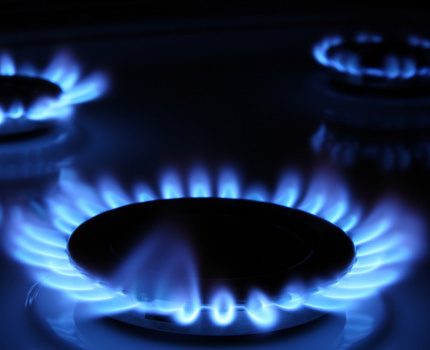
Another alternative to gas is the old and proven way - heating with a fireplace or brick kiln. The main disadvantage of this solution is that the storage of firewood or coal will lead to the appearance of dirt.
In addition, additional square meters will need to be allocated for their storage. Therefore, blue fuel will occupy a leading position for more than a year, and the question is gas pipeline design to connect the private sector for a very long time will be relevant.
The main types of gas pipelines
There are three types of highways. The first is a low pressure gas pipeline. For such a system, the maximum allowable pressure is 5 kPa. Most often, this type is laid in small towns. It is also used for gas supply to medical institutions, residential buildings, children's and public buildings.
For the second variety - medium pressure line - the fuel flow can be supplied with a force of up to 0.3 MPa. The scope of this type is limited to the provision of gas to quarterly and regional regulatory stations.
As for the high-pressure line, it is designed to supply fuel to large industrial enterprises. For owners of private homes, this decision is irrelevant. Indeed, gas is supplied to the cottage by means of a pipe, the pressure in which does not exceed the mark of 5 kPa.
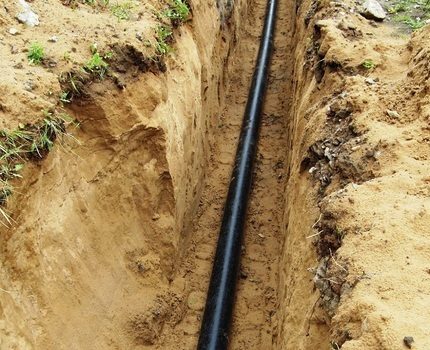
It is written in detail about the pressure parameters and the classification of gas supply networks by its value in article, the content of which we recommend to read.
Norms and standards for pipe laying
Gas enters residential buildings through gas inlets from distribution fuel stations. As a rule, they are installed on the ground floor and then laid along the stairwells. The pipe, which is brought to the residential building, is made without fail by a seamless method, and its wall thickness is at least 3.5 mm.
At a highway to a private house it should be located at least 15 cm from the water supply and heating pipes. In the case of telephone or electric cables, this value increases to half a meter.
The gas pipeline is mainly made of steel. Therefore, to prevent corrosion of the pipe, it is coated with a special insulating material. Due to this, the design does not come into contact with wet soil.
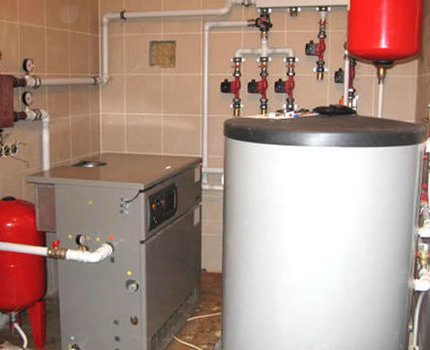
Installation methods and their features
A gas pipeline can be laid by various methods. This is an underground, ground or underwater installation. In buildings, network laying can be done covertly or openly.
Each variety has its advantages and disadvantages. Therefore, before giving preference to any of the varieties, it is necessary to understand in detail all its features.
Advantages and disadvantages of the underground method
More recently, when installing the gas pipeline, the underground method was mainly used. In this case, the pipes are laid in previously dug trenches. Moreover, their depth should exactly correspond to the value specified in the project. Today, such a solution is used less and less.
The drop in demand is associated with the high cost of this type of gasket. In addition, digging holes where pipes will be laid will take quite a while. Currently, engineers prefer the trenchless method. Its feature is the use of equipment that can perform horizontal directional drilling.
Due to this, the cost of laying is reduced three times, and the time required to organize the highway is reduced at least twice.
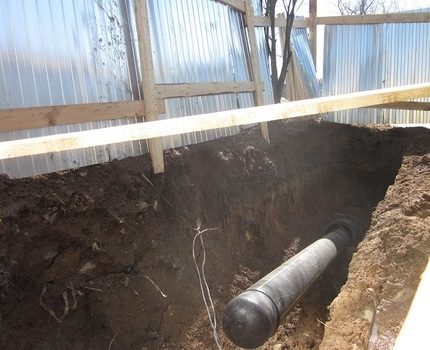
Underground method drilling using HDD equipment frees from the need to restore green spaces. Therefore, this kind of solution can be called the most environmentally friendly. Installation by this method is the drilling of a pilot well, which further expands to the required dimensions.
Further, the walls are strengthened with a special solution. To protect the pipeline from underground water flows and excessive mechanical stress, it is placed in a protective case. The final step is to pull the pipes through the well.
External gas pipeline organization
The external method is most often used. In this case, the gas pipeline, as a rule, extends through the courtyard of the cottage. In this case, the design must be protected from unauthorized persons. To this end, the pipes are located at a considerable height.
Particular attention should be paid to fixation. Fasteners should be as strong and reliable as possible in order to minimize the risk of falling and, as a result, damage to the gas pipe.
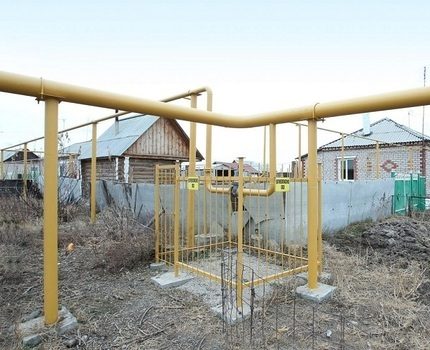
Ground and elevated laying
Compared with the underground installation method, the ground-based one will cost almost half as much. But in this case, special attention should be paid to protecting the structure from environmental influences and mechanical damage.
For example, the pipe should be insulated so that it does not get precipitation and temperature changes are not noticeable. Moreover, the type of protection is selected depending on the climatic conditions of the region.
In order to prevent unauthorized connection to the highway, it is necessary to take care of protection. Indeed, due to the fact that the pipe lies on special supports on the ground, third parties can access it without problems. Therefore, unlike an underground installation, such a solution is less reliable.
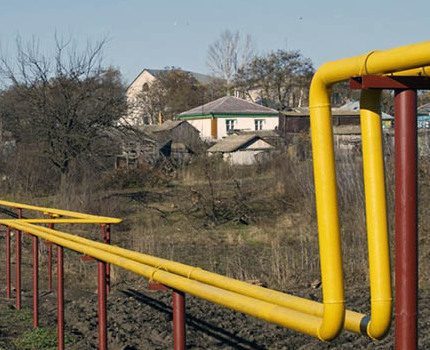
What is the best way to install a gas pipeline?
It is necessary to give preference to a particular solution depending on the climate of the region where the work will be carried out, the density of development and the characteristics of the soil. Accordingly, there is simply no definite answer.
In order to determine which installation method is better to choose, the following recommendations should be considered:
- If the soil on the site is highly corrosive, then the most appropriate solution is to install the gas pipeline by the ground method.
- When crossing a road with a pipeline, a combined option is economically viable. That is, in the area of the canopy, the pipe should be located above the ground, and in the suburban area - laid in trenches.
- In the case of laying the pipeline through neighboring sections, it is recommended to choose the ground (open) method.
- When a gas pipeline passes through a section with an extensive system of power transmission lines, a sensible solution is the hidden installation of the pipeline.
The laying method directly affects the material from which the pipeline is to be made. The issue related to which pipe and fittings to use in a particular case will be considered later.
What documents will be needed?
Before proceeding directly to the installation, you will have to collect the necessary papers.To do this as soon as possible, you must immediately prepare a passport, as well as documentation that confirms the ownership of the site and the house located on it.
The next step is to apply to the appropriate service. It expresses a desire to gasify the house. Employees will issue a form listing all technical conditions.

According to the project, the gas network is being installed. Sometimes pipes are laid through sections of neighbors. In this case, it is necessary to ask them for written permission to carry out this kind of work.
In addition to the papers listed above, you will also need to receive the following documents:
- the act of putting gas-powered equipment into operation;
- an agreement on the preparation of technical documentation and work;
- permission to supply natural gas and pay for this service;
- a document on the installation of equipment and gasification at home.
An inspection of the chimney will also be required. After that, experts will issue an appropriate act. The last document - permission to gasify a private house - is issued by the local architectural and planning company.
How to calculate the diameter of the gas pipeline?
When designing a project, special attention is paid to the diameter of the pipe. The designer will do this using complex formulas or a program.
In order not to bother with a variety of formulas, a good choice would be to use one of the specialized programs. The benefit of such software on the Internet is full. Using calculators is simple - just fill in the fields with the relevant information.

Standard rates for connecting a private household to main gas given here. Owners of suburban areas should know what gasification will cost.
Choice of pipes and fasteners
Since the highway with blue fuel is an object of increased danger, all valves used must have the necessary quality certificates. Otherwise, the commission conducting the final inspection will not allow the house with such pipes to be gasified.
Material selection nuances
The pipe material is selected depending on the method of laying the pipeline. The most popular products are polyethylene and steel. The main advantage of the latter variety is its versatility. After all, steel pipes can be used for both underground and outdoor installation. But such a decision will cost more.
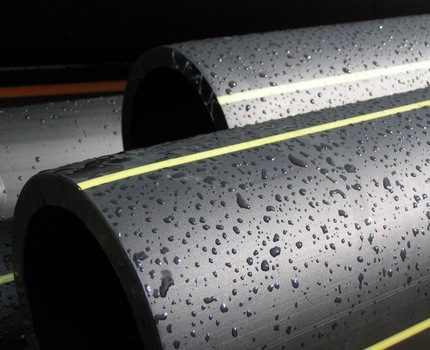
As for the fasteners, for installation you will need angles, couplings, tees, crosses, plugs and adapters. As a rule, they are made of cast iron, steel or polyethylene.
Also, do not hesitate to install the counter. After all, it will significantly reduce costs.
The advantages of polyethylene pipes
First of all, such fittings do not rust over time. Therefore, it allows you to save on maintenance and repair of the pipeline. Thanks to the special production technology, polyethylene products have an absolutely smooth inner surface. As a result, the fuel flow rate in no way slows down.
One of the main advantages of polymer pipes is their safety. They will not appear any stray currents, due to which gas can explode.So in the case of underground installation there is no need to use a special expensive case.
If we compare the weight of a steel pipe and a polymer one, then the latter type is 7 times lighter. This property allows you to significantly reduce the cost of construction, because you do not need to attract equipment with increased payload.
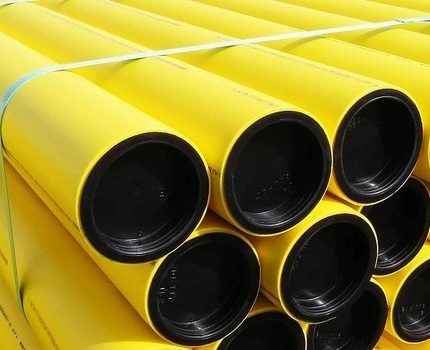
Pipes made of polyethylene, due to their flexibility, have earned the respect of experts. Due to this, installation by the method of horizontal directional drilling will not cause any difficulties or problems. Such a solution is especially relevant when the well is irregular in shape or any obstacles were discovered during its creation.
When to abandon the polymer?
In some cases, polyethylene products will be a poor choice. Limiting conditions include the situation when the temperature of the soil in the winter season can drop below -15 degrees.
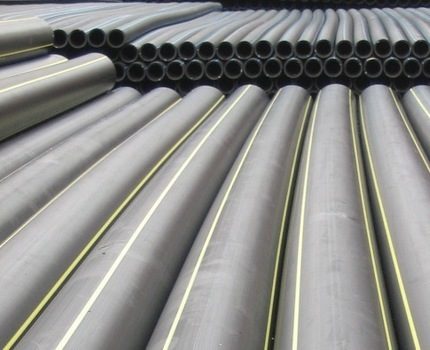
The use of polymer reinforcement is also prohibited in the following situations:
- the pipeline will supply liquefied petroleum;
- An open installation method was chosen;
- if the gas pipeline passes over any obstacles (railway or highway).
After all the necessary products have been purchased and the documents have been collected, you can deal with the features of laying the gas line with blue fuel.
The gas pipeline laying procedure
Despite the fact that the installation of pipes should be done exclusively by professionals with the necessary qualifications, each owner of a private house should familiarize himself with the order of work. This will avoid troubles and the appearance of unplanned financial expenses.
Installation of the riser and preparation of the room
If a private house is gasified in order to organize heating, then you need to take care of the arrangement of the room. A room with all equipment should be separate and have fairly good ventilation. Indeed, natural gas is not only explosive, but also toxic to the human body.
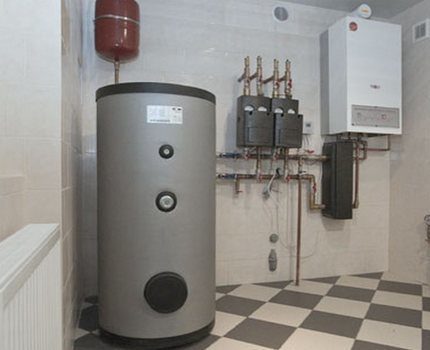
As for the dimensions, the height of the ceilings in the room should be at least 2.2 m. For a kitchen where a stove with two hobs will be installed, an area of 8 m will be enough2, and for the four burner model - 15 m2.
If equipment with a capacity of more than 30 kW will be used to heat the house, the boiler room should be moved outside the house and be a separate building.
Gas is supplied to the cottage by means of an input device, which is an opening above the foundation. It is equipped with a special case through which the pipe passes. One end is connected to the riser, and the second is part of the internal gas supply system.
The installation of the riser is carried out exactly vertically and the structure must be removed from the wall by a distance of at least 15 cm. You can fix the fittings using special hooks.
Subtleties of building an internal system
During the installation of the pipeline in the wall, all its parts must be passed through the sleeves. In this case, the entire structure must be coated with oil paint. The free space present between the pipe and the sleeve is filled with tarry tar and bitumen.
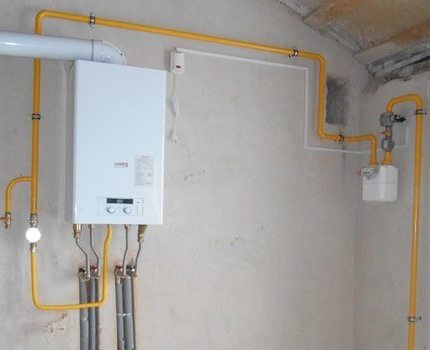
Each of the nodes is assembled at the bottom, and only fixtures of preparatory components are carried out at a height. If the diameter of the pipes does not exceed 4 cm, then they can be fastened with clamps or hooks. For all others, it is recommended to use brackets or suspensions.
Welding, assembly and acceptance rules
Introduces the specifics of the organization of autonomous gas heating next article, detailing the options for heating units. Independent masters come in handy boiler piping schemeslisted in our recommended material.
All components of the pipeline are interconnected by welding. In this case, the seam must be of high quality and reliable. To achieve this, you must first align the end of the pipe and strip about 1 cm on each side.
As for the assembly of threaded connections, for this you need to use a special technique. First, the joint is processed with white. The next step is to wind long-fiber flax or special tape. Only then can the screw connection be tightened.
As soon as the craftsmen finish work, a commission should come to the house. She carried out gas pressure testing and quality control of installation. Moreover, the owner is instructed in accordance with the rules for using the gas pipeline. Employees will also tell you how to properly operate equipment that consumes blue fuel.
Conclusions and useful video on the topic
Video # 1. All about gasification of a private house:
Video # 2. The main stages of installation:
Laying a gas main to a private house is a laborious and responsible process. Indeed, the quality of work directly depends on the impeccability of supply and the safety of residents. Therefore, it is better to entrust the execution of calculations and the installation itself to highly qualified and experienced employees.
Please leave comments in the box below. Tell us how you connected your or a neighboring house to the main gas supply. Ask questions about controversial issues, publish photos with the process of laying pipes or connecting equipment.

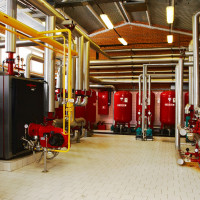 Operation of gas pipelines and equipment: calculation of residual life + regulatory requirements
Operation of gas pipelines and equipment: calculation of residual life + regulatory requirements 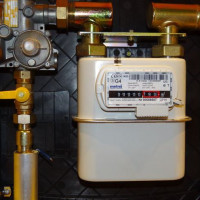 Standards for the distance from the gas meter to other devices: features of the arrangement of gas flow meters
Standards for the distance from the gas meter to other devices: features of the arrangement of gas flow meters 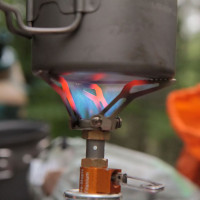 How long is the gas cylinder enough: gas flow calculation for typical gas cylinders
How long is the gas cylinder enough: gas flow calculation for typical gas cylinders  How to determine gas flow: methods for measuring and calculating the fuel used
How to determine gas flow: methods for measuring and calculating the fuel used 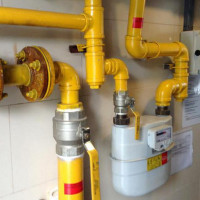 Paint for gas pipes: rules and regulations for painting inside the apartment and on the street
Paint for gas pipes: rules and regulations for painting inside the apartment and on the street  The distance from the gas stove to the hood: the rules and regulations for installing the device
The distance from the gas stove to the hood: the rules and regulations for installing the device  How much does it cost to connect gas to a private house: the price of organizing gas supply
How much does it cost to connect gas to a private house: the price of organizing gas supply  The best washing machines with dryer: model rating and customer tips
The best washing machines with dryer: model rating and customer tips  What is the color temperature of light and the nuances of choosing the temperature of the lamps to suit your needs
What is the color temperature of light and the nuances of choosing the temperature of the lamps to suit your needs  Replacement of a geyser in an apartment: replacement paperwork + basic norms and requirements
Replacement of a geyser in an apartment: replacement paperwork + basic norms and requirements
Our gas is quite cheap, so we decided to fold up once and bring a gas pipeline to our house. Prior to that, they used gas cylinders, but it is quite expensive, despite the fact that they need to be filled about once a month at a gas station. We hired a team of specialists, they competently calculated and quickly done, were satisfied. Now the problem with filling the balloon is a thing of the past.